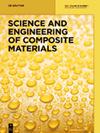加氢石油树脂改性再生混合聚酯/尼龙/氨纶的性能研究
IF 1.6
4区 材料科学
Q3 Materials Science
引用次数: 0
摘要
摘要为了提高回收材料的利用价值,本研究以聚酯/尼龙/氨纶等回收材料为原料。以聚酯/聚酰胺/氨纶为原料,先对回收的聚酯/聚酰胺/氨纶混料进行预处理,得到预处理后的混料。然后,将预处理后的混合材料与加氢石油树脂均匀混合。通过挤压和注射成型制备了复合材料。通过力学性能的比较,研究了不同氢化石油树脂及其添加剂对复合材料的拉伸强度、弯曲强度、冲击强度、断裂伸长率和弯曲模量的影响。并用扫描电镜对断口形貌进行了表征。结果表明:(a)氢化C5石油树脂添加量为4.5%时,最大冲击强度为18.03 kJ/ m2,断裂伸长率为15.92%;(b)当氢化C9石油树脂添加量为4.5%、29.5%和39.5%时,其最大抗拉强度、抗弯强度和抗弯模量分别达到22.9、38.72和2217.9 MPa。本文章由计算机程序翻译,如有差异,请以英文原文为准。
Study on properties of recycled mixed polyester/nylon/spandex modified by hydrogenated petroleum resin
Abstract In order to improve the utilization value of recycled materials, the study considers recycled materials such as polyester/nylon/spandex as raw materials. Using polyester/polyamide/spandex as raw materials, the recycled polyester/polyamide/spandex mixed materials were first pretreated to obtain the pretreated mixed materials. Then, the pretreated mixed materials were evenly mixed with hydrogenated petroleum resin. The composite materials were prepared through extrusion and injection molding. By comparing the mechanical properties, the effects of different hydrogenated petroleum resins and their additives on the tensile strength, bending strength, impact strength, elongation at break, and bending modulus of the composites were investigated. And the microstructure of the fracture surface was characterized by scanning electron microscopy. The results showed that: (a) when the addition amount of hydrogenated C5 petroleum resin was 4.5%, the maximum impact strength and fracture elongation were 18.03 kJ/m 2 and 15.92%, respectively. (b) The maximum tensile strength, bending strength, and bending modulus could reach 22.9, 38.72, and 2217.9 MPa, when the addition amount of hydrogenated C9 petroleum resin was 4.5, 29.5, and 39.5%, respectively.
求助全文
通过发布文献求助,成功后即可免费获取论文全文。
去求助
来源期刊

Science and Engineering of Composite Materials
工程技术-材料科学:复合
CiteScore
3.10
自引率
5.30%
发文量
0
审稿时长
4 months
期刊介绍:
Science and Engineering of Composite Materials is a quarterly publication which provides a forum for discussion of all aspects related to the structure and performance under simulated and actual service conditions of composites. The publication covers a variety of subjects, such as macro and micro and nano structure of materials, their mechanics and nanomechanics, the interphase, physical and chemical aging, fatigue, environmental interactions, and process modeling. The interdisciplinary character of the subject as well as the possible development and use of composites for novel and specific applications receives special attention.
 求助内容:
求助内容: 应助结果提醒方式:
应助结果提醒方式:


